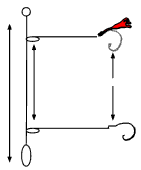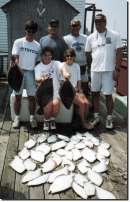by Capt. Stephan Bent, Free Spirit Charters
| Ocean fluke fishing is making a comeback. |
The reasons for this resurgence are yet unclear, but I believe that the program that set a limit on the size and bag limit for the recreational angler and a season and quotas for the commercial fleet are the cause for this resurgence. Granted, the commercial laws are much more lax than those on us, but with our present governor backing the rules and not granting extensions to the commercial quotas, the fishery is definitely coming back. It seems that the commercial boys go out and meet their quotas quickly and that allows us to fish several months unmolested by the trawlers that have historically done damage to the fluke population. If you feel that the last statement was erroneous, please understand that the best fishing for these fish has become the artificial reefs that dot our coast. The structures on those reefs keep the trawlers from fishing there since they would definitely snag and tear the nets. After their season closes, the lumps around the reefs become productive as well. Based on this experience, I rest my case.
Where To Fish
The fishing has been best on the reefs and lumps offshore where depths change from rather deep, (60-70 feet) to a mere hump that rises only to 25-40 feet. If you search a chart, you can almost pick out these places just from the structure and depth changes you see. There are many areas that hold these fish and you should seek out some of the lumps that no one else fishes. There are fish there and the competition is much less than on the more widely known spots.
| The best fishing will be on the down current side of the lump. |
To begin fishing, I generally go to the lump, stop the boat, and allow it to drift for a couple of minutes. This gives me an idea of how to set up for the drift to allow me to drift over the hot spots that I have located before, by finding the bait, or by actually putting a line in the water and catching fish.
It is very important that there be enough wind to drift or you will not catch fluke! I would rather have 15-20 knots of wind than less than 10 knots any day. One a day with no wind, you can also try power drifting. If you are not drifting, you aren't going to catch fish.
Baits and Rigs
 Click to Enlarge |
Another key to catching more fluke is to try to use as little weight as possible. This allows for a better feel of what is going on down there.
One thing that I have discovered is the tremendous advantage of the new no-stretch braids for this fishing. I like Fireline and it is all I use for ocean flounder fishing. I use the 14 lb test and it gets down easier than mono, has a thinner diameter and allows you to really feel the other end of the line.
 Click to Enlarge |
For bait, I like minnows and squid. I try different combos, like plain minnow on the bottom and squid on top, etc., until I find what is working on that trip. One of the best kept secrets of this fishing is the fact that fluke love fresh meat. A strip of snapper blue or Weakfish belly often works great but the best is a strip of sand shark meat. When you catch a sand shark, fillet it and skin it. Then, slice the meat into strips and put them on the hook all by themselves. It is often magic! Sea Robin is second best and works well, also. Be sure that you hook the baits only one time through the end so they will flutter as you drift. Some of the largest fish we catch are on a gigantic strips of shark!
Hooking Up
As for hooking the fish, you will catch as many on a dead stick that is in a holder as you will when you are holding the rod. The secret is to always be in contact with the bottom. When you think you have a bite, relax, wait, talk to your buddy, but don't strike it right away. Simply lift slowly and, if there is weight there, lift a bit harder and you will have him.
Conclusions
I hope that you will be helped by this how-to and remember, catch as many as you want but keep only as many as you can use. Watch the bag limits and good fishing to you all. If you should hear the Free Spirit on VHF Ch. 68, give me a shout!